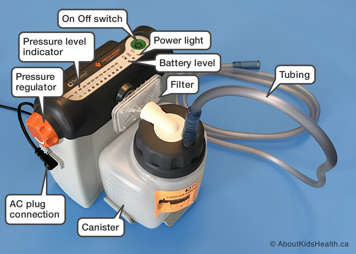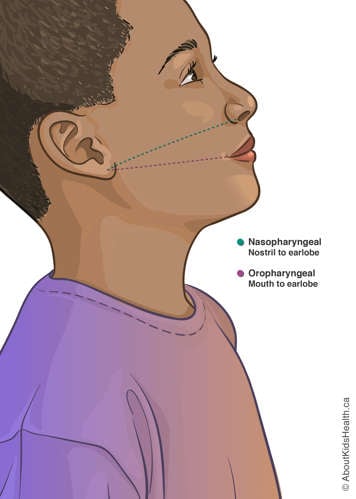Suction machines
No matter what type of suctioning you perform, you will need to use a suction machine. A back up manual suction setup is helpful to have on hand in case the powered suction machine malfunctions.
There are portable suction machines that use batteries and stationary suction machines that plug into an electrical outlet. It is recommended that your suction machine is portable so that you can “suction on the go” when you are away from home.
Many brands of suction machines are available. Your local medical supplies vendor will help you decide which one is best for your child. The vendor will also teach you how to use the suction machine you decide to buy. When purchasing your suction machine, be sure to ask about the suction machine’s warranty.

All suction machines have:
- an outlet filter
- canister
- pressure display panel or gauge
- pressure regulator (allows you to control the pressure)
- AC plug and/or a battery and charger
- a power switch
Precautions
Between suctions, remember to plug the portable suction machine into an AC wall outlet so that it will charge and be ready to use when you need it next.
- When using the machine in AC power mode, the on/off light will appear.
- When using the machine in battery mode, the on/off switch will not light up.
The battery on a fully-charged suction machine should last about 45 minutes, but this will vary from machine to machine. Aim to use the battery for only 30 minutes at a time so that it can re-charge more quickly.
How do I know the right size catheter for my child or how far I can suction?
In general, the recommended suction catheter sizes and suction depth depend on the size of your child and the type of suctioning being done. As a general guideline, for nasal, nasopharyngeal and oropharyngeal suctioning, the size of the suction catheter should not be any larger than half the size of your child’s nostril.
Identifying the correct suction depth
- For nasal suctioning measure from your child’s nostril to the middle of the nose.
- For nasopharyngeal and oropharyngeal suctioning measure from your child’s nostril to the tip of the earlobe.
- Record the suction depth on the tape measure or make note of the number marking on the catheter and record this number.
- Attach the tape measure to the cot/bedside/suction machine for future use.


Use pre-measured suction catheters (where available) to ensure accurate suction depth.
Your child’s health-care provider will review with you what type of suction your child needs, the suction catheter your child needs, how far to insert the suction catheter and which pressure setting to use for the suction machine.
| Suction catheter size: | |
| Depth of suction catheter insertion for suctioning: | |
| Suction machine pressure setting (mmHg): |